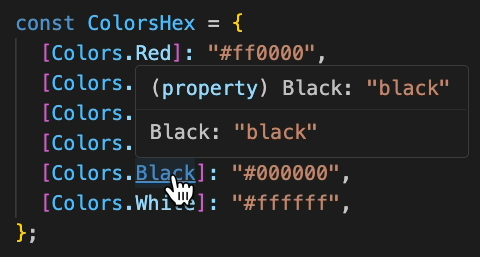TL;DR:Typescript's built-in enum structure can be replaced with a better object const pattern. The advantages of this pattern include flexibility over values and ability to exploit IDE features such as auto-suggest and "go to source".
Typescript's built-in enum structure is woefully inadequate, to the point that even the Typescript team saw fit to list pitfalls and alternatives of enum in their documentation.
One recommended alternative is to declare an object const object with as const.
In this article I will describe how I implement this pattern as both an object and a derived type.
Pattern#
Here's how I implement object const:
const Enums = {
Entry: "value",
Entry: "value",
Entry: "value",
} as const;
type Enum = TypeOfConst<typeof Enums>;The implementation of TypeOfConst is a very simple one-liner:
type TypeOfConst<Const> = Const[keyof Const];I typically put it in a shared utils file and export it.
Example#
Here's an example for enumerating a few colors:
const Colors = {
Red: "red",
Green: "green",
Blue: "blue",
Purple: "purple",
Black: "black",
White: "white",
} as const;
type Color = TypeOfConst<typeof Colors>;We can use the Color to access a type that can be one of the values and Colors.{xyz} to access the values themselves.
For example, we can use Color as the type of a backgroundColor field on an interface definition:
interface ButtonProps {
readonly backgroundColor: Color;
}And then set its value using Colors:
const buttonProps: ButtonProps = {
backgroundColor: Colors.White,
};Advantages#
The advantages I've found in this approach are:
- Flexible values
- Auto-suggest on container and values
- Easy "go to source" on container
Flexible values
Unlike a simple union of values, with an object const, we can separate the name of each entry from its value. This allows us more flexibility with the values, which can be strings, numbers, objects or any other type that can be assigned.
Auto-suggest on container and values
With an object const, we get nice auto-suggest when we enter dot (".") after the const name.

Even better, because the object const itself is named, we can use auto-suggest to find it and import it anywhere.

This wouldn't be possible with a simple union of values.
Easy "go to source" on container
With an object const, we can use our IDE to quickly preview and/or navigate to the const source.
For example, in Visual Studio Code, we can Cmd+MouseOver the const name to see its source in a pop-up, and Cmd+Click to be taken to the source code.

Conclusion#
I think the object const pattern above provides a viable enumeration pattern for most use-cases in Typescript.
Contents
